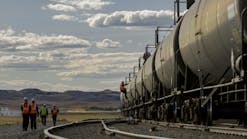The American Trucking Associations (ATA) and other industry groups urged Congress to act quickly on improving the country’s freight foundation following the recent State of the Union address, in which President Trump called for “a great rebuilding of America’s crumbling infrastructure.”
Chris Spear, ATA’s CEO, said he approved of Trump’s proactive calls to address infrastructure issues and modernize the United States’ trade relationship with its neighbors through the new United State-Mexico-Canada Agreement (USMCA), which was signed by the three countries’ leaders in November but still needs Congressional approval.
“President Trump called for a national, bipartisan effort to restore our country’s declining infrastructure—and America’s truckers are answering that call,” Spear said. “A win on this issue will require real investment, not budgetary gimmicks as tried in years past. That is why America’s truckers, along with a broad coalition of the business community, have pledged our financial commitment to making this national priority a reality.
“Decades of failed leadership in Washington have led us to this point, which is why we commend the President for seizing this opportunity to bring all sides together to forge a common path forward. Restoring our national infrastructure to greatness will further ignite our economy, make us more competitive abroad, and give Americans more time to spend with family and less time stuck in traffic.”
Spear said trucking and trade are synonymous, making swift ratification of USMCA a necessity.
“Trucks move $720 billion worth of goods annually across our borders with Canada and Mexico, and cross-border trucking activity supports more than 47,000 jobs in the United States,” he said. “Any significant disruption to those trading relationships would have serious consequences for trucking and the economy, so we join President Trump in his call for Congress to quickly ratify the USMCA trade agreement.”
Stephen E. Sandherr, the CEO of the Associated General Contractors of America, also asked Congress to act on the President’s call for new infrastructure investments that support continued economic growth.
“President Trump understands that one of the most effective ways to ensure continued economic growth is through making needed investments in our roads, bridges, water systems and other public infrastructure,” Sandherr said. “These economic benefits accrue from the expansion of new, high-paying construction career opportunities. But the more significant economic gains will come as we make our economy more efficient by relieving congestion, making drinking water safe for all and improving safety.
“We strongly urge Congress to act on the President’s call to craft new, bipartisan infrastructure legislation. This association and our tens of thousands of member firms will work tirelessly to educate and encourage members of Congress to take the steps needed to improve our aging and over-burdened infrastructure. Our message will be clear, the most effective way to support continued economic growth and prosperity is by investing in infrastructure.”
The Coalition for America’s Gateways and Trade Corridors (CAGTC) pleaded with the Trump administration and Congress to unite in bipartisan support of improvement to the country’s “unacceptable” infrastructure, and outlined what it says are key elements of a “freight-focused multimodal competitive grant program” for high-priority goods movement projects.
CAGTC said the United States’ five major economic sectors—manufacturing, retail, agriculture, natural resources and transportation—represent 85% of the country’s national economy, and rely on the “efficient and cost-effective” movement of goods, and insisted that goods movement projects, both highway and multimodal, reduce congestion for all motorists.
“Infrastructure investment is a bipartisan issue at its core,” said Elaine Nessle, CAGTC executive director. “For too many years, federal freight infrastructure investment has lagged while our population and national economy grow. This financial burden cannot be shouldered by states, localities and the private sector alone. There needs to be a commitment to driving an investment plan at the federal level. Existing programs are oversubscribed and international trading partners are outpacing our investments at a rapid clip—increased funding dedicated to freight infrastructure is necessary in order for the US to remain competitive in the world marketplace.
“CAGTC and its membership look forward to working with 116th Congress and the Administration to develop a plan that will strengthen freight infrastructure and deliver economic returns for years to come.”
The freight system moves 55 million tons of goods daily, worth more than $49 billion, CAGTC said. That’s roughly 63 tons per person annually. Meanwhile, the US population is expected to increase by 70 million by 2045. Freight movement across all modes is expected to grow nearly 42% by 2040.
The Coalition has long advocated for a grant program that uses objective, performance-based merit criteria to select high-priority goods movement projects in any infrastructure proposal, including the following elements:
- A national strategy that guides long-term planning: A national “vision” and investment strategy that prioritizes and guides investment in the nation’s freight infrastructure system with active coordination among states, regions and localities.
- Dedicated, sustainable, and flexible funding: A long-term, sustained investment program dedicated to multimodal freight infrastructure that ensures public agencies invest in their most critical goods movement needs—regardless of mode. Adequate Federal funding should incentivize and reward state and local investment and leverage the widest array of public and private financing.
- Merit-based criteria for funding allocation: Projects should be selected through the use of merit-based criteria that identify and prioritize projects with a demonstrable contribution to national freight efficiency. Modally blind funds should be available to support multi-jurisdictional and multi-state projects, selected on the basis of objective measures designed to maximize and enhance system performance.
- Partnership with the private sector: Federal funding should leverage private participation and provide transportation planners with the largest toolbox of financing options possible to move freight projects forward quickly and efficiently. Private sector funding will not replace or diminish the need for federal resources, but in many instances can be used to augment system expansion.
To view a compilation of the nation’s most critical freight infrastructure projects, see CAGTC’s Freight Can’t Wait booklet.









